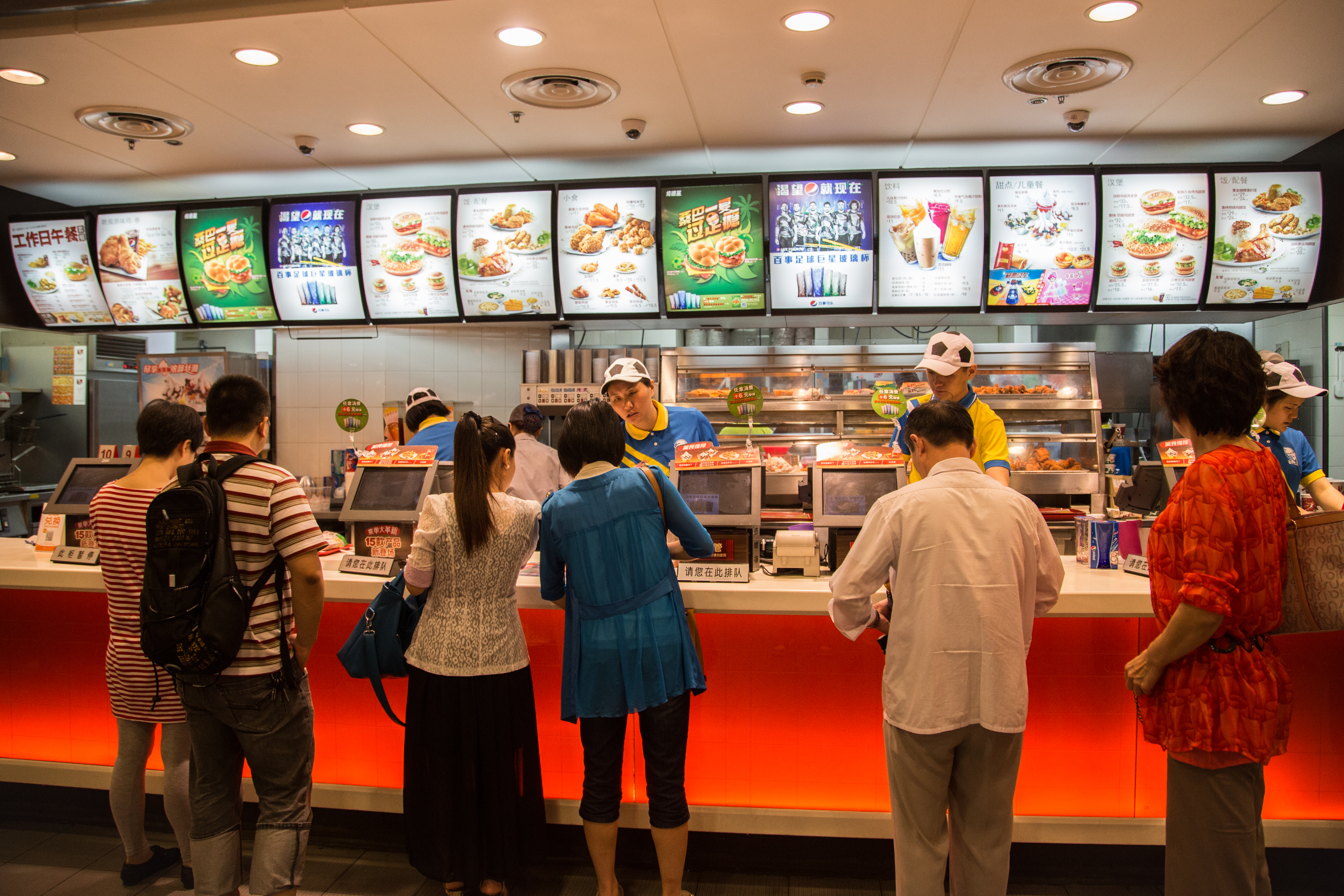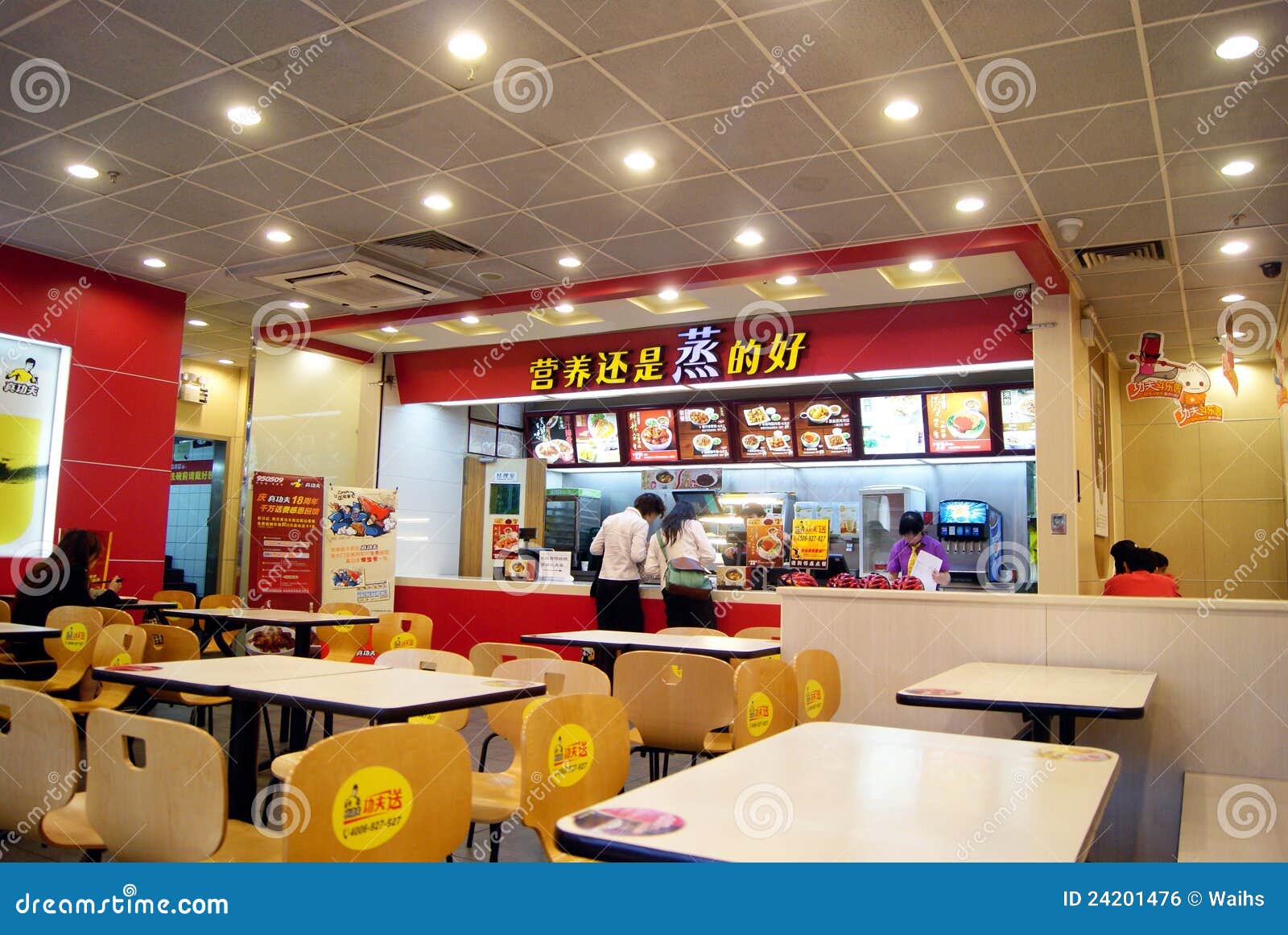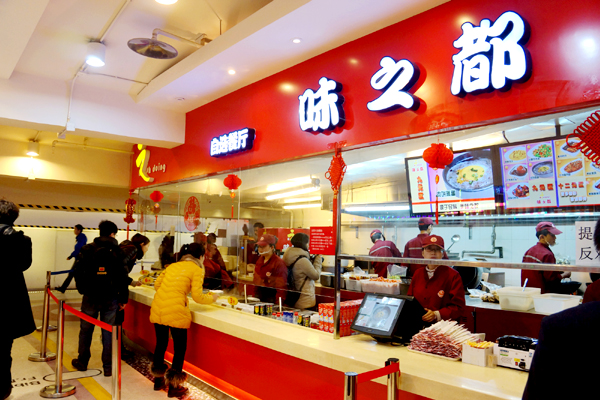Fast food restaurant
A fast food restaurant is a restaurant where the emphasis is on fast service and rapid consumption of food. The offer is limited, the service by the staff is reduced and the prices are lower than those of other restaurants. The food offered often fall into the category of fast food. Often quick-service restaurants belong to regional to global companies or franchise chains. Many fast food restaurants are self-service restaurants. The quick -service restaurants are a part of American diner and drive-in restaurants. To ensure the rapid delivery of the ordered food, they are often accused of already prepared ready and only warmed up.
The main difference between a snack bar and a fast food restaurant is that the snack does not have seats and the selection of food is less. The similarities lie in the standardization of the offer and the limited space.
The usual fast-food restaurants today came after the Second World War in the United States. As the first restaurant chain of this type, the company White Castle, which initially only sold hamburgers applies. The quick service in the 1950s, McDonald's was perfected by the rational manufacturing of the products through strict division of tasks in the kitchen.
Self-service
Each self-service restaurant is a fast food restaurant, because the self- serving guests is primarily the shortening of stay. In Fast Food vendors this restaurant form is the rule. In organizational terms, between the self-service on-line, where the guest is guided along in a queue on a long counter, free-flow, where the guest has the opportunity to move freely and at various individual counters and showcases, which are placed freely in the room can select and take-away, where the guest is served at a central sales counter with cash register, distinguished.
Cafeteria
Cafeteria is in Europe and in the U.S. the name of a fast food restaurant with self-service, in which customers typically sequentially with a tray in hands on containers and display cases pass in a queue ( on-line ) with hot and cold dishes, from which they meet their individual choice, which they then pay at the cashier before they take place at a table. The dishes and drinks will be provided in a line in a display case in a bain-marie, on a chafing dish, in cabinets or in vending machines (for example, coffee or soup).
This restaurant form arrived in the United States at the end of the 19th century as an inexpensive alternative to the usual service restaurants that were too expensive for unskilled workers. Despite the similar sounding name, a cafeteria is not a café and differs from this principle through its menu and its concept. The organizational and operational concept of the cafeteria has been adopted by many canteens, cafeterias and motorway service stations.
The word cafeteria was imported in the 19th century in the United States from the Mexican Spanish, and since the beginning of the 20th century, basically the name given to a particular form of self-service restaurants. The Spanish word cafeteria called in Mexico a kind of cafe where there were alcoholic beverages and snacks. The term was derived from the word cafetero for coffee seller. In the U.S., the word cafeteria is occupied since 1853, first for California. 1917, the term was included in U.S. dictionaries. Especially in a university environment is often the colloquial shortening Cafete encountered.
History
The invention of the cafeteria principle is a complaint in the United States by several people. An early cafeteria, which was reserved exclusively for men, there was supposedly in 1885 in New York. Similar facilities for women opened the Young Women's Christian Association in New York and Chicago. These early cafeterias took the place of works canteens, about the many companies at that time did not have. An important role for the distribution of this fast-food restaurants played the World's Fair in Chicago in 1893, at the cafeteria was presented.
As the first operator of purely commercially operated cafeterias William and Samuel Childs, in New York a buffet of various dishes and the self-service introduced in 1898 with trays for the customers are. The coffee shop idea first spread in California, the south and the southwestern United States, however, followed a few time later with the introduction of self-service in simple restaurants that offered no snacks but still full meals. Shortly after 1900, the still common concept of the classic cafeteria had become well established in Childs, where customers queuing up with a tray in a queue and pass by a number of various dishes on offer. In Los Angeles, the first commercial coffee shop in 1905, which promoted so that the guests can watch the preparation of the food and save the tip for the service opened. This was followed by San Francisco and Washington, D. C.
Machines Restaurant
The automatic restaurant is a self-service restaurant with seating, where all meals and drinks to be kept in vending machines that are equipped with a coin slot, so that the customers in the restaurant have no contact with service personnel. The world's first fast-food restaurant of this kind was opened by Ludwig Stollwerck in Leipziger Strasse in Berlin in 1896. It was set up by the German machine company Stollwerck & Co., the Ludwig Stollwerck had founded together with the inventors Max Sielaff and Theodor Bergmann 1895. Ludwig Stollwerck and Max Sielaff had a " vending Pavilion" in 1886 exhibited at the International Industrial Exhibition. Other cities with "Automatic buffets " followed, before the First World War, Germany had around 50 machines restaurants.
1887 had Stollwerck Ludwig and his American business partner John Volkmann Volkmann, Stollwerck & Co founded, who took over the vending machine business in the U.S.. From 1898, Volkmann, Stollwerck & Co. opened Machines Restaurants in San Francisco, New York, Philadelphia, St. Louis and other American cities. In the U.S., the first automatic restaurant opened in 1902 in Philadelphia; it belonged to the Horn and Hardart Company. It was soon followed by other branches of that operator, but they were successful except in Philadelphia, only in New York. In 1950, the two cities together about 85 machines restaurants in 1979 there were only two. Most of the former branches of Horn and Hardart were taken over by Burger King. In the 1950s and 1960s tried several fast-food chains to go into the vending machine business, including White Tower Hamburgers with a system called Tower -O -Matic, but none were successful. Most customers felt almost personal free restaurants as too impersonal.
In the Netherlands of the 20th century have emerged as " Eten uit de muur " again, including through the chain FEBO machines end restaurants.










